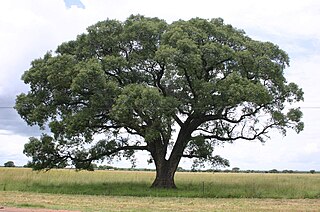
Sclerocarya birrea, commonly known as the marula, is a medium-sized deciduous fruit-bearing tree, indigenous to the miombo woodlands of Southern Africa, the Sudano-Sahelian range of West Africa, the savanna woodlands of East Africa and Madagascar.
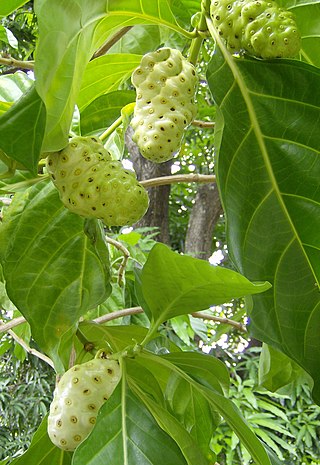
Morinda citrifolia is a fruit-bearing tree in the coffee family, Rubiaceae, native to Southeast Asia and Australasia, and was spread across the Pacific by Polynesian sailors. The species is now cultivated throughout the tropics and widely naturalized. There are over 100 names for this fruit across different regions. Common English names include great morinda, Indian mulberry, noni, beach mulberry, vomit fruit, awl tree, and cheese fruit.

According to the Quran, Zaqqoum or Zaqqum is a tree that "springs out of the bottom of Hell". It is mentioned in verses 17:60, 37:62-68, 44:43, and 56:52, of the Quran.

Ziziphus mauritiana, also known as Indian jujube, Indian plum, Chinese date, Chinee apple, ber and dunks is a tropical fruit tree species belonging to the family Rhamnaceae. It is often confused with the closely related Chinese jujube, but whereas Z. jujuba prefers temperate climates, Z. mauritiana is tropical to subtropical.

Irvingia gabonensis is a species of African trees in the genus Irvingia, sometimes known by the common names wild mango, African mango, or bush mango. They bear edible mango-like fruits, and are especially valued for their fat- and protein-rich nuts.

The wildlife of Egypt is composed of the flora and fauna of this country in northeastern Africa and southwestern Asia, and is substantial and varied. Apart from the fertile Nile Valley, which bisects the country from south to north, the majority of Egypt's landscape is desert, with a few scattered oases. It has long coastlines on the Mediterranean Sea, the Gulf of Suez, the Gulf of Aqaba and the Red Sea. Each geographic region has a diversity of plants and animals each adapted to its own particular habitat.

The Orman Garden is one of the most famous Botanical gardens in Egypt. It is located at Giza, in Cairo. It dates back to 1875 and the reign of Khedive Isma'il Pasha who established the garden on a larger site than it presently occupies as part of the Palace of the Khedive. A great lover of gardens, the Khedive entrusted the design of the garden to the French landscaper Jean-Pierre Barillet-Deschamps. It became a public botanical garden in 1910/1917 and put under the Ministry of Agriculture management.
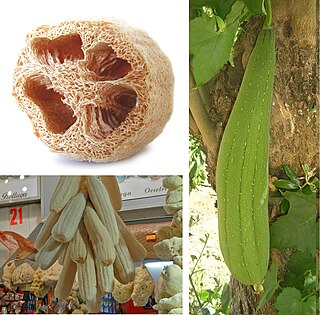
Luffa aegyptiaca, the sponge gourd, Egyptian cucumber or Vietnamese luffa, is an annual species of vine cultivated for its fruit, native to South and Southeast Asia.
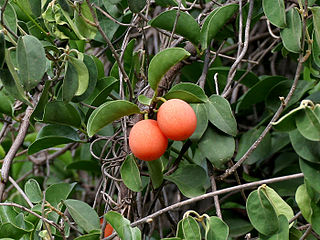
Ximenia americana, commonly known as tallow wood, hog plum, yellow plum, sea lemon, or pi'ut (Chamorro), is bush-forming shrub/small tree; a species from the Ximenia genus in the Olacaceae family. It is mainly found in the tropics, ranging from Africa, India and southeast Asia, to Australia, New Zealand, Pacific Islands, West Indies, Central, North and South America. It is especially common in Africa and South America. It is not domesticated so it is only found occurring in the wild.
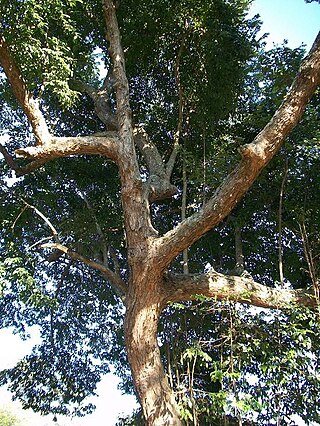
Margaritaria discoidea is a tree in the family Phyllanthaceae, commonly known as the pheasant-berry, egossa red pear or bushveld peacock-berry. These trees are native to the warmer, higher rainfall areas of Africa.

Sclerocroton integerrimus, the duiker berry, is a tree in the family Euphorbiaceae, from Southern Africa.

Balanites is an Afrotropical, Palearctic and Indomalayan genus of flowering plants in the caltrop family, Zygophyllaceae. The name Balanites derives from the Greek word for an acorn and refers to the fruit, it was coined by Alire Delile in 1813.

Treculia africana is a tree species in the genus Treculia which can be used as a food plant and for various other traditional uses. The fruits are hard and fibrous, can be the size of a volleyball and weight up to 8.5 kg (19 lb). Chimpanzees have been observed to use tools to break the fruits into small pieces that they can eat. The fruits contain polyphenols.
Ephysteris subdiminutella is a moth of the family Gelechiidae. It is a widely distributed species, it is known from northern and southern Africa, from Egypt to South Africa, Australia, Palestine, India, Pakistan and Afghanistan. It is also found in the Galápagos Islands.

Ximenia caffra, the sourplum, is a small tree or small shrub that is thinly branched. It is part of the Olacaceae family which is native throughout tropical regions. In particular, the sourplum is native to regions in South East Africa, mainly Botswana, Kenya, Malawi, Mozambique, South Africa, Tanzania, Uganda, Zambia, and Zimbabwe. The sourplum tree produces several fruits on an annual basis. These are generally sour with a dry aftertaste, and they contain significant amounts of potassium. The tree itself is fairly hardy, with frost resistance and drought tolerance. The tree, fruit, seed, leaves, and roots are all used for human consumption, medicinally, or for fuel. The trees themselves can also be used as natural land division barriers.
Balanites glabra is a species of tree or shrub, classified either as a member of the Zygophyllaceae or the Balanitaceae. This tree is native to East Africa.
Balanites wilsoniana is a species of fruit-bearing tree from west and central Africa from the caltrop family (Zygophyllaceae).
Balanites angolensis, or Angolan green-thorn, is a species of tree from southern Africa, it is a member of the caltrop family, Zygophyllaceae.
Balanites pedicellaris, the small green-thorn or small torchwood is a small tree or shrub from Sub-Saharan Africa. It is a member of the caltrop family Zygophyllaceae.
Balanites rotundifolia, known in Swahili as Mbamba ngoma is a spiny bush or small tree from eastern Africa and southern Arabia. It is a member of the caltrop family, Zygophyllaceae.

















